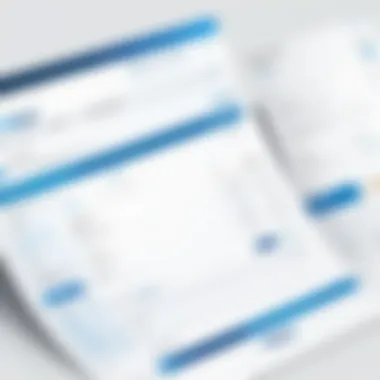A Comprehensive Guide to Invoicing with PayPal


Intro
In the modern business realm, efficient billing practices significantly contribute to overall operation success. An effective invoicing system ensures timely payments and streamlined financial interactions with clients. PayPal, recognized for its user-friendly interface and robust features, stands out as a top choice for businesses of all sizes aiming to enhance their invoicing efficiency. This guide delves into PayPal's invoicing process, highlighting its various capabilities and presenting best practices for maximizing payment timeliness. By understanding PayPal's invoicing functionalities, businesses can better ensure financial health and client satisfaction.
Software Overview and Benefits
PayPal is not just a payment processing platform; it offers comprehensive invoicing tools designed to simplify transactions and enhance communication with clients.
Key features include:
- Customizable invoices: Users can tailor invoices using personal branding elements.
- Automated reminders: This feature helps minimize late payments by reminding clients when invoices are due.
- Easy tracking: Users can monitor payments and outstanding invoices in real-time.
- Mobile access: Invoices can be sent and managed from a mobile device, making it highly convenient.
The primary benefits of employing PayPal for invoicing include increased efficiency in billing and facilities aimed directly at addressing pain points like managing overdue payments. These features cater specifically to the needs of tech-savvy business professionals striving to maintain a reliable cash flow.
Pricing and Plans
Understanding the pricing structure is essential for businesses considering PayPal for invoicing. PayPal operates on a transaction fee basis, typically charging a percentage of the transaction plus a fixed fee. This translates to roughly 2.9% + $0.30 for domestic transactions in the United States. Businesses engaged in international transactions might face varying fees. Despite potential upkeep costs, PayPal remains cost-effective compared to some competitors, especially for small to medium-sized enterprises.
Moreover, there are no recurring subscription fees for using PayPal's invoicing features, allowing businesses to enjoy low overhead costs.
Performance and User Experience
Performance is a crucial factor in any invoicing software. PayPal's invoicing system is generally recognized for high reliability and speed. Users praise the intuitive interface, making the creation and sending of invoices a simple task, even for individuals not tech-savvy.
User feedback often indicates that waiting times for payment processing are minimal, and inaccuracies are rare, further contributing to a positive experience.
Integrations and Compatibility
The versatility of PayPal is enhanced by its ability to integrate with numerous platforms and tools. Notable integrations include accounting software like QuickBooks and project management tools such as Trello. These connections enable seamless workflows between invoicing and existing business operations.
Additionally, PayPal's compatibility spans multiple operating systems, including Windows, macOS, iOS, and Android. This wide-ranging compatibility ensures that users can invoice clients effectively, regardless of their device of choice.
Support and Resources
PayPal offers several customer support options. Users can access a comprehensive help center and receive direct support through chat or email. Additionally, instructional videos and tutorials can assist users in navigating the invoicing platform more effectively.
For deeper insights, online communities on platforms like reddit.com can provide seasoned user feedback.
Understanding PayPal Invoicing
PayPal invoicing is more than simply a method of sending bills. It acts as a critical tool for many businesses to fulfill their billing needs seamlessly and efficiently. The understanding of this invoicing system can help businesses optimize their payment collections, contributing to better cash flow management. Knowing the ins and outs of PayPal invoicing will equip businesses with the skills needed to make financially sound decisions and elevate operational success.
What is PayPal Invoicing?
PayPal Invoicing is a feature provided by PayPal that allows users to create and send digital invoices to clients or customers. By leveraging this tool, businesses can present a professional front in their transactions without investing in expensive software.
The invoicing process is quite simple. Users can customize the invoice design, add itemized services or products, and include payment methods suited to the recipients’ preferences. Typically, recipients can then complete the payment using their PayPal account or various credit choices. This integration simplifies how customers interact with the transaction as they often prefer quick and easy solutions.
Benefits of Using PayPal for Invoicing:
Using PayPal for invoicing has numerous advantages:
- Ease of Use: PayPal's intuitive interface makes it easy for users to set up and send invoices without needing technical expertise.
- Faster Payments: With a straightforward payment link included in invoices, clients can make payments with minimal friction, leading to quicker transaction turnovers.
- Automated Reminders: Users can automate follow-up reminders for unpaid invoices, which is valuable in maintaining cash flow without manual interventions.
- Customizability: Users can customize the invoice format to suit their branding, ensuring that each invoice represents the business identity professionally.
- Reporting Features: PayPal offers insightful reporting tools, enabling businesses to track payment status, assess income, and better manage bookkeeping tasks.
It is essential for any modern business to harness effective invoicing systems to manage accounts efficiently.
By delving into these aspects, users can enhance their invoicing outputs through PayPal, leading to fewer obstacles in the overall financial process.
Setting Up Your PayPal Account


Setting up your PayPal account is a critical first step before you can start invoicing effectively. A proper setup lays the groundwork for seamless transactions between you and your clients. This aspect is pivotal as it ensures that you can send and receive payments without encountering issues. In this section, we will explore how to create a PayPal business account, along with important steps to verify your account.
Creating Your PayPal Business Account
A PayPal business account is fundamentally different from a personal account. It is designed to suit the needs of businesses, plus it offers several functionalities not available in personal accounts. When you create a business account, you gain access to advanced invoicing options and customer management tools.
To create your account, go to the PayPal website and click on the ‘Sign Up’ button. You'll be prompted to choose between personal and business accounts. Opt for the business account and enter the necessary information, including your email address and a secure password. Afterwards, complete the forms with details about your business—like its name, phone number, and indeed, your business address. A complete profile is key to having a trustworthy image for clients.
Once you've completed all information forms, special attention should be given to the type of business you operate and the merchant category. This ensures that your transactions will be categorized appropriately. A good set up facilitates a smoother invoicing process and can reduce complications when it comes to taxation.
Verifying Your Account
Verification of your PayPal account is another vital step. It serves multiple advantages, including higher transaction limits and improved credibility among customers. By scanning certain validations such as bank accounts or credit cards, you further empower your ability to manage finances confidently.
To verify your account, after logging in, navigate to the
Creating an Invoice with PayPal
Creating an invoice with PayPal is a pivotal step in the payment process for businesses and freelancers. An invoice serves not only as a request for payment but also as a formal record of the goods or services provided. Proper invoice creation is essential for maintaining professionalism, tracking payments, and ensuring timely cash flow.
By utilizing PayPal’s platform, users tap into functionality that can streamline the entire billing process, offering features such as customizable templates, automated tracking of payment history, and integrated reminders for unpaid bills. These attributes greatly assist in reducing administrative overhead and enhancing efficiency when managing customer payments.
Navigating to the Invoicing Section
To create an invoice on PayPal effectively, the first step is to navigate to the Invoicing section. After logging in to your PayPal account, you will find an intuitive interface on your dashboard. Look for the “Invoicing” tab, typically located on the left side of the page.
Clicking on this section leads you to a page specifically designed for invoicing options. Here, you will see options such as “Create Invoice,” along with links to manage existing invoices. This easy access is crucial for users who wish to quickly transition billing tasks without navigating through multiple pages.
Selecting Invoice Template Options
Once you have accessed the Invoicing section, selecting an invoice template is your next task. PayPal offers various templates that cater to different business styles and sectors. Choose one that resonates with your brand identity while ensuring clarity and professionalism.
Each template comes with features that allow for personalization. Users can easily add their business logo, choose color schemes, and select matching styles for better visual presentation. This consistency not only reinforces branding but also aids in retaining a polished appearance across all customer communications.
Adding Line Items and Details
After selecting the desired template, the next significant step is adding line items and specifics to the invoice. Clear and accurate line items are critical as they breakdown the charges according to specific products or services delivered.
Include the following details for every line item:
- Description: A brief explanation of the service or product provided.
- Quantity: The number of items or hours worked.
- Rate or Price: How much is charged per unit or hour.
- Subtotal: Calculate the total for each line before any tax or discounts.
Additionally, PayPal enables you to include discount and tax fields if necessary. Taking advantage of these features not only makes the invoice precise but also facilitates easier payments from clients, as transparency reduces misunderstandings related to fees.
By following these structured steps, you are setting a strong foundation for effective invoicing that can profoundly impact your payment collection process.
Sending Invoices through PayPal
Sending invoices through PayPal is a critical component of the invoicing process for many businesses. This fundamental action not only streamlines cash flow but also enhances professional interactions with clients. Digital invoicing offers speed, convenience, and accuracy compared to traditional methods. Each invoice can be customized to reflect the brand’s identity while utilizing automation features that decrease manual effort.
When sending invoices via PayPal, one can safeguard against illumination errors and potential account discrepancies. Furthermore, receiving payments becomes prompt, as PayPal's established user base often favors its time-saving payment method of one click. Establishing a reputable invoicing method through PayPal wordlessly emphasizes professionalism and efficiency in the business world.
Reviewing Your Invoice Before Sending
Before sending any invoice, it is critical to conduct a thorough review. Double-checking ensures accuracy in all elements such as the client's information, itemized services, and charges. In particular, erroneous billing can lead to payment delays, disputes, and dissatisfied clients.
Key Elements to Review
- Client Details: Ensure all client information is accurate, especially email addresses. A mistake can result in invoices going to the wrong recipient.
- Invoice Amounts: Verify that all calculations are correct and inclusive of taxes or additional fees.
- Due Dates: Recheck the invoice’s due date to avoid confusion. It helps emphasize payment urgency.


Taking this extra time for proofreading can save hassle down the road. Besides, it demonstrates a high level of attention to detail, conducive to the notion of good customer service.
Sending the Invoice to Clients
Once you have reviewed the invoice, the next step is sending it to your client. PayPal provides a couple of efficient ways to ensure that this is done effectively.
One way is via email from within the PayPal invoicing section. You can directly input the client's email or select from previous contacts. The system also allows adding customized messages, which help personalize the communication.
Steps to Send the Invoice
- Select the appropriate verified email recipient.
- Verify the content again shortly.
- Click on the ‘Send’ button.
Alternatively, one can generate a link to share through other platforms. This method can work well if the client regularly uses communication through channels like WhatsApp or online project management tools.
Tracking Sent Invoices
After sending invoices, monitoring their status stands as an indispensable step. PayPal includes features to track if invoices have been viewed by clients. The visibility status notifies you if another follow-up is necessary, offering cues for timely communications.
Being organized tends to influence Custer accounts positively, as follow-up communications show clients they are valued. Maintaining stated records allows you to methodically approach communication and anticipate cash flow better.
In addition, by clustering seen and unpaid invoices through PayPal, you may gain insights into overall payment behaviors, which can be a useful tool for strategic financial planning.
Regularly checking invoice statuses is essential for effective cash flow management and reinforces structured workflows in invoicing.
Managing Invoices with PayPal
Managing Invoices with PayPal is crucial for maintaining efficient payment processes in a business. This functionality provides more than just tracking payment statuses; it allows the user to oversee the overall health of their cash flow. Adopting these methods can save time, reduce errors, and enhance communication with clients. Given the fast-paced digital economy, effective management ensures businesses can respond promptly to financial situations.
Viewing Payment Status
The ability to view payment status in PayPal is fundamental for any business owner or freelancer. It helps in determining whether an invoice has been paid in full, partially paid, or remains unpaid. The PayPal dashboard offers a clear overview of these statuses. This can assist you in making informed decisions on next steps, such as follow-ups or service deliveries. Each invoice displays an indicator that shows its current status, making it easy to manage multiple invoices simultaneously. By routinely checking payment status, businesses can take timely actions to secure revenue.
Handling Unpaid Invoices
Unpaid invoices can pose significant challenges for a business. Understanding how to handle them effectively can assist in minimizing cash flow problems. With PayPal, businesses can utilize their invoicing features to mark invoices as pending, overdue, or followed up. Moreover, categorizing and keeping records of unpaid invoices becomes essential. This helps in understanding if there are recurrent clients delaying payments. In some cases, directly re-sending an overdue invoice through PayPal may rekindle your client's attention to outstanding amounts.
- Some effective strategies include:
- Segmenting overdue accounts by payment history for tailored approaches.
- Sending out tailored communication emphasizing payment policies to stubborn clients.
- Offering various payment methods, which could reduce friction related to invoicing.
Not addressing unpaid invoices can hurt the overall financial well-being of a business. It is helpful to create systematic processes for handling them promptly.
Sending Payment Reminders
Payment reminders are significantly essential for ensuring timely payments. This feature can be particularly valuable when dealing with clients who might overlook due dates.
Using PayPal to send payment reminders is straightforward. You can choose to automatically send reminders, or set reminders manually based on your accounting needs.
• It’s often beneficial to customize your reminders for different clients. • For instance, using a friendly tone for regular clients whom you value may yield better responses, while a more formal reminder may be suited for infrequent clients.
“Regular communication about payments can strengthen relationships and proactively avoid issues related to unpaid invoices.”
Ultimately, reminding clients politely, but firmly, establishes clear boundaries regarding payment expectations, enhancing overall business professionalism.
Integrating PayPal Invoicing with Other Tools
Integrating PayPal invoicing with other tools is critical for efficiency, especially in today’s fast-paced business environment. Businesses often rely on multiple systems to manage operations. Combining these with PayPal streamlined invoicing can vastly improve workflow. This section will delve into two vital integrations: synchronizing with accounting software and using PayPal with e-commerce platforms.
Synchronizing with Accounting Software


Many businesses use accounting software to track finances. By integrating PayPal invoicing with programs such as QuickBooks, Xero, or FreshBooks, users can automate data exchange. This leads to improved accuracy and reduced errors. Additionally, this synchronization helps keep records consistent across systems.
When invoices are generated in PayPal, they can be automatically recorded in accounting software, eliminating the need for manual entry. This integration supports easier tracking of profits and losses, enabling better financial forecasting. Some important elements of this synchronization include:
- Real-time Syncing: Data updates happen automatically, so decisions are based on the latest figures.
- Time Savings: Reduce time spent on clerical tasks.
- Improved Reporting: Generate accurate financial reports efficiently.
Automated systems tend to result in swift payments and clearer records, which can enhance client relationships and reduce the chance for disputes.
Using PayPal with E-commerce Platforms
E-commerce platforms are fertile ground for integrating PayPal invoicing. Many online retailers and service providers use platforms such as Shopify, WooCommerce, or Magento. Providing a seamless payment experience for clients can increase conversion rates and enhance customer satisfaction. Here, we explore some key benefits:
- Increased Flexibility: PayPal integration allows businesses to offer multiple payment options to customers based on their preferences.
- Automated Invoicing: E-commerce platforms can trigger invoices automatically every time a transaction is made, ensuring no payment is overlooked.
- Settling Disputes: Integrating allows better tracking of payments and orders, making it easier to resolve any potential issues with clients.
Setting up PayPal with your e-commerce platform may involve adjusting some configuration settings. Most widely used platforms provide straightforward guidelines to assist with the integration. Overall, the combination not only simplifies invoicing but also contributes to overall operational efficiencies. Employing such integrated solutions can result in significant procedural advantages for businesses aiming for streamlined processes.
Best Practices for Efficient Invoicing
Efficient invoicing is central to managing cash flow for any business. Adopting best practices in invoicing ensures not only faster payment but also improves the overall business-client relationship. By adhering to these methodologies, you can minimize discrepancies and foster timely communications throughout the invoice lifecycle.
Clear and Professional Invoice Design
The first step to effective invoicing is to have a visually appealing and orderly invoice layout. A clear design conveys professionalism to your clients. Key elements include:
- Your business logo.
- Detailed contact information (name, email, phone number).
- Client’s contact information.
- An itemized list of services or products provided.
- Clearly stated due date.
Using colors and typography that complements your brand can make your invoice stand out without being distracting. A tidy organization of information also aids clients in locating key details, leading to swifter payments. Remember to adhere to a consistent format throughout all invoices for brand coherence.
Setting Payment Terms
Payment terms establish a clear expectation for the timing of payment. They can include:
- Due dates (net 30, term conditions).
- Accepted payment methods (PayPal, credit card).
- Discounts for early payments, fees for late payments.
Providing specific payment terms communicates professionalism. Moreover, clearly stated due dates help in planning your cash flow more effectively. By giving incentives for early payments, like a small percentage off the invoice price, clients may feel motivated to expedite their payments. Be explicit in your terms to avoid misunderstandings.
Ensuring Prompt Follow-up
Having a system for following up on unpaid invoices is critical. It’s best practice to send reminders soon after an invoice’s due date passes. Follow-ups should be polite but firm. Here’s a simple follow-up strategy:
- Reminder one day past due: Gentle nudge concerning the outstanding payment.
- Reminder one week past due: Polite reminder with a request for payment status.
- Send formal notice two weeks post due date: Specify penalties if payments remain unpaid.
Practicing diligent follow-up expedites resolution and leads to timely payments. Evaluation of your follow-up strategy can also inform adjustments to invoice terms as needed, fostering a more effective billing process across your business.
Remember, an invoice is more than just a request for money; it reflects your business’s reliability and can significantly influence client relationships.
Epilogue
In this article, we have delved into the multifaceted approach to invoicing through PayPal, examining the various stages from creating invoices to managing payments efficiently. The topics discussed are crucial for any business looking to optimize its billing processes. By understanding PayPal's invoicing features, users can enhance their operational productivity and achieve financial clarity.
Utilizing PayPal invoicing offers several advantages. Firstly, its integration with e-commerce platforms and accounting software provides a seamless experience that enhances efficiency. In addition, using a clear and professional invoice design assures clients of the legitimacy and seriousness of the billing process.
Equally important is setting clear payment terms. When clients know what to expect, they are likelier to meet their obligations, reducing the incidence of unpaid invoices.
Moreover, sending timely follow-ups can significantly influence the payment speed, as it serves as a gentle reminder of outstanding amounts. Thus, the concluding message encapsulates the vital need for clarity, process, and consistency in invoicing through PayPal.
Summary of Key Takeaways
- PayPal Invoicing simplifies billing processes for businesses.
- Clear and professional invoice designs contribute to client trust.
- Setting specific payment terms informs clients, promoting quicker transactions.
- Tracking and sending reminders improve timely payments and account management.
Further Resources for Invoicing
For expanding one’s understanding of invoicing and PayPal's extensive features, the following resources can be beneficial:
- Wikipedia on Invoicing
- Britannica's Business Guide
- Reddit Discussions on PayPal
- Facebook Business Help Center







